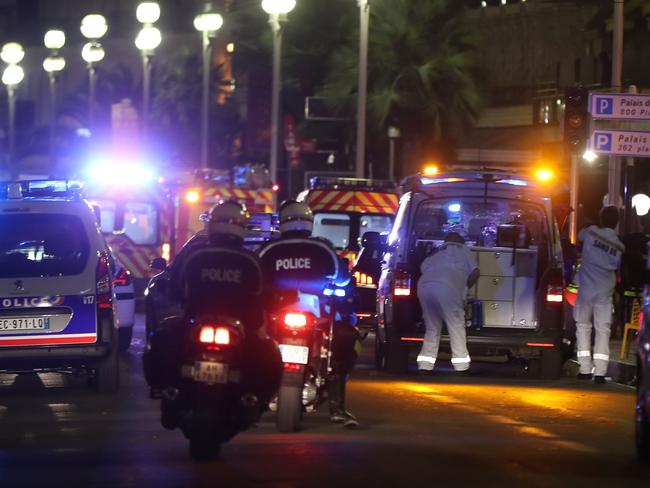Mohamed Lahouaiej Bouhlel named truck killer by local media in Nice
THE driver of the truck that killed at least 84 people in a terror attack in Nice has been formally identified. WARNING: Graphic
WARNING: Graphic images
THE driver of the truck that killed at least 84 people in a terror attack in Nice has been formally identified, according to reports, most notably the BBC.
Mohamed Lahouaiej Bouhlel, 31, was identified by newspaper Nice-Matin which cited local sources.
He was a dual Tunisian-French national who lived in Nice.
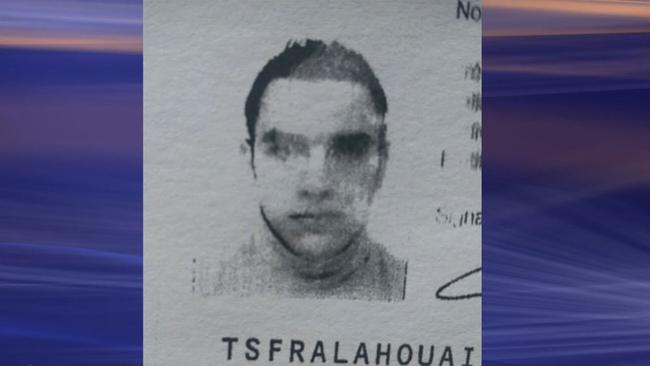
Police had previously said that they had formally identified the man, after finding ID cards in the truck he used to kill 84 people, during Nice’s Bastille Day celebrations.
French President Francois Hollande says that about 50 people are still “between life and death” and in a critical state, including many children, after the attack.
Hollande, "We have an enemy who will carry on striking against all people, all countries that cherish freedom." https://t.co/LwKfkGsYGM
— Sky News (@SkyNews) July 15, 2016
The 31-year-old truck driver was shot dead by police.
WARNING: Video below is distressing
Video has emerged of French police shooting the driver of a truck in #Nice who had killed at least 84 people https://t.co/A4lKUxwxb0
— Sky News (@SkyNews) July 15, 2016
According to Nice-Matin, sources said Mohamed Lahouaiej Bouhlel worked as a delivery driver, and had been a father for three years.
French prosecutor François Molins said that Mohamed Lahouaiej Bouhlel was known to police and the courts “due to threats, violence and petty theft between 2010 and 2016”.
He was “detained on the 23rd of March on 2016” and sentenced to six months, for a road rage incident. “There was an altercation between him and another driver and he hurled a wooden pallet at the man”.
He had also been detained for “voluntary violence with weapon and that was in January 2016”.
Authorities were “not aware that he had ever shown a sign of radicalisation”.
Investigators are still looking to find whether the man was working with accomplices. They raided his home and Sky News later reported his ex-wife was held for questioning.
L'appartement du terroriste présumé de Nice passé au peigne fin ce matin pic.twitter.com/n6Qp15NmIA
— Catherine Marciano (@clmarciano) July 15, 2016
His relatives are also being questioned by police.
Neighbours of the man have described him as a loner with no visible religious affiliation, as forensic experts searched his flat.
The truck was rented on 11 July, and was due back on the 13th.
Inside the cabin, there were automatic fire weapons, two Kalashnikov rifles, bullets and a grenade. Earlier reports had suggested the weapons were fakes.
A mobile phone, a driver’s licence and bank details were also found.
AFP reporters interviewed about a dozen neighbours of the man.
They portrayed him as a solitary figure who rarely spoke and did not even return greetings when their paths crossed in the four-storey block, located in a working-class neighbourhood of Nice.
Sebastien, a neighbour who spoke on condition that his full name was not used, said Lahouaiej-Bouhlel did not seem overtly religious, often dressed in shorts and sometimes wore work boots.
He had a van parked nearby and owned a bike, which he brought up into his first-floor apartment.
The lorry used in last night's attack in Nice is removed from the scene https://t.co/0W8GDhhCnY
— Sky News (@SkyNews) July 15, 2016
Of those who were interviewed, only one, a neighbour on the ground floor, said she had had any concerns about him - he was “a good-looking man who kept giving my two daughters the eye.” Police investigators and forensic experts entered his apartment around 9.30am (local time) with an armed police intervention unit in support, and brought out bags of material later.
A source close to the investigation said an “inactive” grenade was found inside the vehicle, as well as “several fake rifles.” President Francois Hollande has declared the attack was of “an undeniable terrorist nature.” “Investigations are currently underway to establish if the individual acted alone or if he had accomplices who might have fled,” interior ministry spokesman Pierre-Henry Brandet said.
The attack bears the hallmark of Islamist militants, the prosecutor said.
“(The investigation) will try to determine whether he benefited from accomplices (and) it will also try to find out whether Mohamed Laouaiej Bouhlel had ties to Islamist terrorist organisations,” Francois Molins told a news conference on Friday, referring to the divorced father of Tunisian nationality.
“Although yesterday’s attack has not been claimed, this sort of thing fits in perfectly with calls for murder from such terrorist organisations.” Molins, who said Bouhlel’s ex-wife was in police custody, added that the man had shot several times at policemen before his vehicle was stopped and he was killed.
Paris Prosecutor outlines that 84 people have been killed and 200 injured in the #NiceAttack https://t.co/xbuPCy2O7A
— Sky News (@SkyNews) July 15, 2016
Meanwhile, passengers evacuated from Nice airport were allowed to return and pick up their luggage, a reporter at the scene said. The airport had earlier been cleared of people.
Sky News reported the hospital treating children injured in the attack in Nice as saying it had been unable to trace some of their parents.
.@fhollande says "The world's eyes are upon us and the world is expressing its solidarity with us." https://t.co/afmIDj9QAp
— Sky News (@SkyNews) July 15, 2016
President François Hollande addressed the nation and revealed that many of the 84 people killed were children. At least 18 are in a critical condition.
After Hollande’s speech, AFP claimed the interior ministry had confirmed the death toll had risen to 84.
He announced thousands of troops and police would be mobilised in the wake of the horror attack and the country’s state of emergency would be extended by three months. It was due to end on July 26.
“This is a monstrosity to use a truck to deliberately kill people, many people, who only came out to celebrate their national day,” Hollande said. “France is in tears, she is hurting but she is strong. She will be stronger.”
The death toll has been climbing since the attack began about 7.00am AEST. A spokesman for France’s Interior Ministry said “it’s going to be a very high toll”. The driver is among the dead.
The incident interrupted a fireworks display for the national celebration when the huge truck rammed into the crowd celebrating on the French Riviera.
#Nice victim: "there was debris and people lying seriously injured... It was quite unlike anything I've ever seen" https://t.co/CZRk0FDfxl
— Sky News (@SkyNews) July 15, 2016
Mown down bodies remain strewn on the streets and the scene has been described as “apocalyptic” and “carnage on the road”.
Christian Estrosi, president of the region, says the truck in that caused carnage in the southern city was loaded with grenades, guns and larger weapons.
Witnesses have described “running over bodies”. A French journalist at the scene said: “I saw bodies flying like bowling pins along its route. Heard noises, cries that I will never forget.”
A man who witnessed the attack told CNN he saw the driver accelerate and aim for people as the vehicle slammed the crowd. The truck continued about 2km through the city’s busy main road, mowing down people in its path.
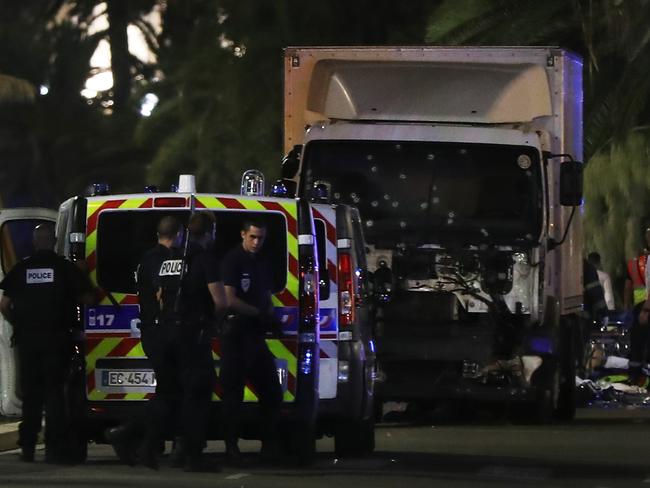
The driver then emerged from the truck and opened fire on the crowd, another eyewitness said. French media is now reporting the gunman got back in the driver’s seat and travelled to another populated area before starting to shoot again.
Police opened fire on the truck which crushed revellers and sent people running for their lives. The truck’s driver was shot dead.
French President Francois Hollande said the attack was clearly a “terrorist” act.
Unconfirmed reports are circulating suggesting terror outfit Islamic State has claimed responsibility for the attack.
According to French media, the driver was known to police for petty crimes, but not for terror-related activity.
The driver was a 31-year-old man of Tunisian origin and a resident of Nice. Details of his identity were obtained from papers found in the shot up truck following the attack.
The truck driver was said to have shouted “allahu Akbar” (God the great) before being shot dead by police, local newspaper Nice-Martin reported.
French newspapers have previewed their front pages following the overnight attack.
Words like “carnage” and “horror” will dominate newsstands, accompanied by grim pictures of the shot up attack truck and lifeless bodies on the city’s streets covered by sheets.
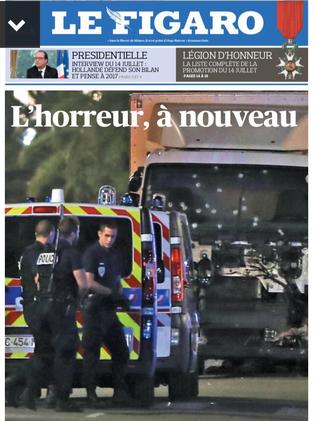

Witnesses have reported people being hit by debris flying around the scene, and videos have emerged on social media showing people fleeing in panic.
Images of streets strewn with bodies have been published online by witnesses as authorities warn locals and tourists to stay indoors.
“The driver of a van appears to have killed dozens. Stay in your homes for now. More info to follow,” mayor Christian Estrosi wrote on Twitter.
Local authorities from the Alpes-Maritimes prefecture also urged people to remain indoors following what appeared to be a deliberate attack on crowds who had been watching the annual fireworks display from the famed Promenade des Anglais.
Mouvement de panique !! #Nice pic.twitter.com/RgXar3fWZs
— HARP DETECTIVES (@harp_detectives) July 14, 2016
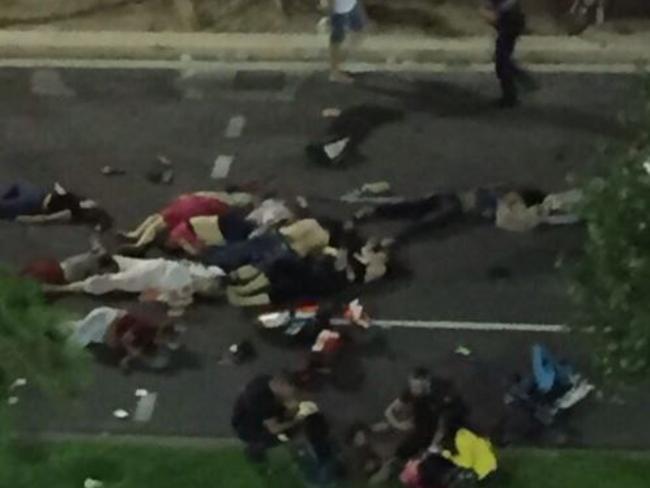
Police remain on the scene of the attack and have begun a large scale investigation.
Anti-terrorist investigator have taken charge of the prove.
Interior ministry spokesman Pierre-Henry Brandet told AFP investigators had begun investigating the attacker.
“An individual drove a truck into the crowd. He was killed by police,” he said.
“Investigations are currently under way to establish if the individual acted alone or if he had accomplices who might have fled.”
Local authorities have declared the fatal act “a clear, criminal attack”, but Mr Brandet said it was too early to be certain of the killer’s motivation.
Nice prosecutor Jean-Michel Prette said bodies were strewn about along the roadway. However he stopped short of using the word attack, while acknowledging that “it has many ingredients of an attack that allow us to think that”.
Other local authorities have not hesitates in using the word attack, with some going as far as to call it an act of terrorism.
Panic has also broke out in France where the Eiffel Tower became engulfed in smoke.
The fire is not to believed to be terror-related and is not being treated as an attack.
The attack has seen President Hollande announce the nation’s state of emergency, which was to end on July 26 following the Paris attacks, will be extended by three months.
In an address following the attack, President Hollande confirmed children were among the victims, and expressed solidarity with their families.
“I’m expressing, on behalf of the nation, our solidarity with the victims and with their families,” he said in translated French.
President Hollande said all means available would be deployed to help the injured.
“France is in tears. It is hurting but strong. Always stronger than the fanatics who wish to hurt us,” he said.
“We must show vigilance and determination without end.”
He added that France would strengthen its role in Iraq and Syria.
“We will continue to hit those who attack us on our soil in their homes,” he said.
.@fhollande says state of emergency in France will be extended and France will show 'real force' in Syria and Iraq https://t.co/CmoalIUz7g
— Sky News Australia (@SkyNewsAust) July 15, 2016
Prime Minister Malcolm Turnbull has spoken to the Governor-General, Australia’s ambassador in France, and New Zealand Prime Minister John Key following the attacks.
In a statement, he labelled the massacre a “murderous act of terror”.
We mourn for the victims of another murderous act of terror in France overnight, on Bastille Day https://t.co/BZ18IJJaKb
— Malcolm Turnbull (@TurnbullMalcolm) July 15, 2016
Governor-General Peter Cosgrove offered sympathies to the government and people of France in a public statement.
“On a day where Australians marched alongside their French counterparts this cruel attack has struck innocents celebrating their national day. Our deepest thoughts and sympathies are with the government and people of France,” he said.
Australian Opposition Leader Bill Shorten has described the attack in the French city of Nice as another tragedy inflicted on innocent people.
The Labor leader said the scenes in the French Riviera city on Bastille Day were “awful” and Australia stands with its friends in France.
His deputy and the party’s foreign affairs spokeswoman, Tanya Plibersek, said their thoughts are with the loved ones of those who have died or are injured.
Foreign Minister Julie Bishop has confirmed the Department of Foreign Affairs and Trade is providing consular assistance to Australians caught up in the attacks and were “urgently seeking to determine whether any other Australians have been affected”.
Addressing media, Ms Bishop said three Australians had been injured.
The department has reissued travel advice for France to reflect the attack.
“We continue to advise Australians to exercise a high degree of caution in France,” Ms Bishop said in a statement.
“Australians in Nice should remain attentive to their surroundings, avoid affected areas and follow the instructions of local authorities.”
The French flag has been lowered to half-mast at the French Embassy in Australia. #9News pic.twitter.com/zmll7V2krn
— Nine News Sydney (@9NewsSyd) July 15, 2016
At the French Embassy in Australia, the French flag has been lowered to half mast.
Australian telco Optus has announced free calls to France on the network.
Tour company Top Deck has confirmed one of its Australian travellers suffered minor injuries.
Australian witnesses have begun to share their accounts of the horrifying scene.
Emily Watkins, an Australian journalist in Nice, told ABC she was less than 50m from the incident and saw the truck.
“There was a lot of confusion. I don’ tactually remember seeing the truck moving,” she said.
“There was a lot of screams coming from ahead of us where the truck was, and people just running towards us, and without really knowing what was going on we turned and ran as well.”
A 22-year-old Sydney women, Bridget, gave her account of the attack to Sky News.
US President Obama declared it “a horrific terrorist attack” in a statement he released condemning the act on behalf of the American people.
“On behalf of the American people, I condemn in the strongest terms what appears to be a horrific terrorist attack in Nice, France, which killed and wounded dozens of innocent civilians,” he said.
“Our thoughts and prayers are with the families and other loved ones of those killed, and we wish a full recovery for the many wounded.”
President Obama highlighted the significant of Bastille Day, and said the US would stand in solidarity and partner with France: “Our oldest ally”.
“On this Bastille Day, we are reminded extraordinary resilience and democratic values that have made France and inspiration to the entire world, and we know that the character of the French Republic will endure long after this devastating and tragic loss of life.”
New British Prime Minister Theresa May is being kept up to date on the “terrible incident” in Nice, a Downing Street spokesman said Friday.
“Our thoughts are with all those affected by this terrible incident on what was a day of national celebration,” the spokesman said.
President Hollande will return to Paris for crisis talks over the Nice attack.

The attack is the third in less than two years that has killed more than 100 people and left hundreds more wounded.
An attack on November 13 left 130 people dead. Some of the nine militants blew themselves up near the Stade de France stadium, others opened fire on downtown cafe terraces and a third group armed with guns and suicide vests killed 90 music fans at the Bataclan rock concert hall.
It followed an attack in January last year where jihadists attacked the Charlie Hebdo magazine and a Jewish supermarket that left 17 dead.
Earlier this week, France’s most senior security chief predicted Islamic extremists would look to increase their capacity to kill by using booby-trapped cars and bombs.
Testimony by Patrick Calvar, who heads the internal intelligence agency DGSI, and other top security officials was made public Tuesday in a 300-page report by a parliamentary commission that examined French means to fight terrorism.
According to AP, the report revealed numerous intelligence lapses that paved the way for the attacks in January and November 2015 that together killed 147 people.
Mr Calvar said in his May 24 testimony before the commission that he foresaw an evolution in how extremists carry out attacks in France, and presumably the West, notably that they will use techniques that can kill more people — and spare the attackers.
“I’m convinced they’ll go to booby-trapped vehicles and bombs, thus upping their power,” he said.
“We know very well they’re going to use this mode of operating. They’re going to end up sending commandos whose mission is to organise terrorist campaigns without necessarily going to the assault with death awaiting them.”
He also raised the possibility of extremists using “dirty bombs” and the natural poison ricin, saying several groups had studied the toxin in the past.
The Armed Islamic Group, which rained terror on Algeria in the early 1990s, was looking to put it on car door handles to create a panic effect, Mr Calvar said, and it was studied in northern Iraq and in the remote Pankisi Valley in Georgia, once a stronghold of Chechen militants.
Mr Calvar did not elaborate on when this new approach to attacks could become an imminent threat to France or other Western targets. He noted before the commission that he cannot tell all.

Earlier on Thursday, President Hollande confirmed the state of emergency which France declared after last November’s deadly Paris attacks would come to an end on July 26.
According to AFP, President Hollande said the decree after the November 13 attacks would not be renewed because a law bolstering security in France was adopted in May.
“We had to prolong the state of emergency until we could be sure that the law gives us the means to counter the terrorist threat effectively,” he said in a traditional Bastille Day television interview.
The new law “will give us the tools which, while not comparable with the state of emergency, give us the means to keep tabs on certain individuals administratively,” he added.
“We can’t prolong the state of emergency forever. That would make no sense, it would mean that we were no longer a republic with laws which can apply in all circumstances,” he said, while acknowledging that the threat “remains there.”
Hollande declared the state of emergency on the evening of the November 13 attacks and it was extended three times by parliament, notably to include the euro 2016 football tournament and the Tour de France cycle race.
